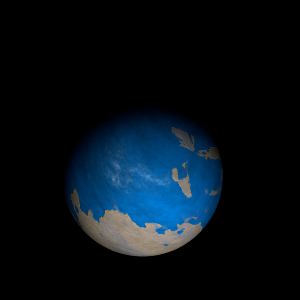|
|
Space Astro
|
Info for exoplanet "Maor"
| Scientific (actual) data |
|---|
| Name | OGLE-2017-BLG-0373L b |
| Planet status | Confirmed |
| Discovered | 2018 |
| Updated | 2020-03-30 |
| Publication | Published in a refereed paper |
| Detection type | Microlensing |
| Star name | OGLE-2017-BLG-0373L |
| Right ascension | 269.33° |
| Declination | -31.95° |
| Star distance | 5900 |
| Star mass | 0.25 |
| Wikipedia article | OGLE-2017-BLG-0373L b |
Back
| |
| Fictional info (?) |
|---|
| Suggested name | Maor |
| Planet type | Cold planet |
| It has the longest rotation period (445 days) of any planet in its solar system and rotates in the opposite direction to most other planets.
It is a cold planet planet with a mass one-thousandth that of OGLE-2017-BLG-0373L, but two-and-a-half times that of all the other planets in its solar system combined. It is the coldest planetary atmosphere in its solar system, with a minimum temperature of 60°K (-213°C), and has a complex, layered cloud structure with sulfur dioxide thought to make up the lowest clouds, and hydrogen chloride the uppermost layer of clouds.
It may have had hydrogen peroxide oceans in the past, but these would have vaporized as the temperature rose due to a runaway greenhouse effect. |
| Atmosphere | Hydrogen chloride | 89% |
| Sulfur dioxide | 11% |
| Hydrogen peroxide | 0.1% |
| Water vapor | 0.018% |
| Atmospheric pressure | 0.0028 bar |
 |
| No known satellites |
| Google search for Maor |
|
Website by Joachim Michaelis
|
|
|
|